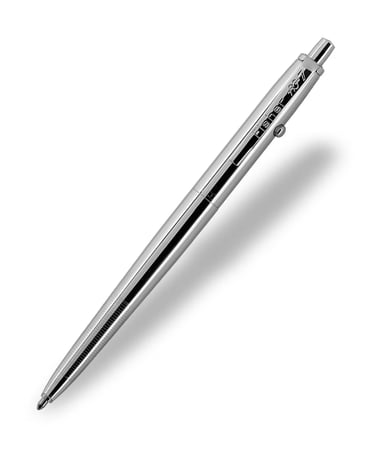The Pen, the Pencil, and the Space Race:
A Tale of Innovation, Myth, and Misunderstanding
10/15/20254 min read


When we think of the Space Race — rockets roaring into the void, astronauts floating gracefully through orbit — the last thing that comes to mind is stationery. Yet one of the most enduring stories about Cold War ingenuity revolves not around engines or computers, but something much simpler: how to write in space.
The story goes like this:
When NASA began sending astronauts into space, they quickly discovered that ballpoint pens didn’t work in zero gravity. The ink relied on gravity to flow, so the agency reportedly spent millions of dollars developing a special “space pen” that could write upside down, underwater, and in a vacuum.
Meanwhile, their Soviet counterparts — ever pragmatic — simply used pencils.
It’s a great story: simple, moral, and funny. It reinforces stereotypes — the Americans overengineering a solution, the Russians relying on practicality and simplicity. The only problem? It isn’t true.
The Myth and the Reality
NASA never spent millions developing a space pen. In fact, both American astronauts and Soviet cosmonauts originally did use pencils — mechanical pencils with graphite leads encased in wood or plastic.
But pencils had serious drawbacks in space. Broken graphite tips and shavings floated in microgravity, posing a hazard. Graphite is also conductive, which meant even tiny fragments could short-circuit sensitive electrical systems. On a spacecraft where every component was tightly packed and mission-critical, that was no small risk.
Enter Paul C. Fisher, an American inventor and pen manufacturer. In 1965, Fisher independently developed the AG-7 “anti-gravity pen” — a pressurised ink cartridge that could write in any orientation, at extreme temperatures, and even underwater.
NASA tested it extensively and, finding it safe and reliable, purchased a modest number for about $2.39 each. No multi-million-dollar development program, no government funding. Just private innovation solving a practical problem.
And in an interesting twist, a few years later, the Soviets also adopted Fisher’s pen for their Soyuz missions. The same tool, used by both sides of the ideological divide, not because of political pride — but because it worked.
Design Lessons: Context is Everything
The pencil-vs-pen story endures because it encapsulates a tension familiar to every designer and engineer: Do we overengineer or underthink our problems?
The truth is, neither NASA nor the USSR were foolish. They were adapting to a new environment — one where gravity, air pressure, and static electricity behaved differently, and even a simple mistake could spell disaster.
This is a powerful design lesson: innovation isn’t about “cleverness” — it’s about context. The same pencil that worked perfectly on Earth became a hazard in orbit. A pen that seemed unnecessary on Earth became essential in space.
Every design must answer a single question: Does it work here, in this environment, for this purpose?
At Plan R, this same principle guides how we think about habitats beyond Earth. A structure that functions beautifully on Earth may fail utterly in the vacuum and temperature extremes of the Moon or Mars. Just as the pen and pencil had to evolve for new conditions, our approach to building must evolve too — from traditional, gravity-dependent architecture to inflatable, robotic, and adaptive systems that respect their environment rather than fight it.
Parallel Innovation: Lessons for Habitat Design
Let’s extend the analogy.
The Pencil represents heritage thinking — tools and techniques that have served humanity for millennia. In habitats, this might mean rigid walls, gravity-based construction, or Earth-centric design standards. They’re comfortable and familiar — but sometimes unsafe or inefficient in new environments.
The Pen represents adaptive innovation — solutions designed for a fundamentally different context. Pressurised ink isn’t revolutionary in itself, but in zero gravity, it’s transformative. Likewise, an inflatable habitat inside a lava tube isn’t “futuristic” for its own sake — it’s simply what works in that environment.
Both the pen and the pencil are valuable. What matters is choosing the right one for the right place.
Beyond the Myth: Innovation as Evolution
The beauty of the ballpoint pen story isn’t in who was “smarter,” but in how innovation evolves. The Fisher Space Pen didn’t appear overnight. It was the result of countless incremental improvements — from quills to fountain pens to ballpoints — each iteration shaped by the environment, materials, and needs of its time.
Similarly, the habitats of the future won’t spring fully formed from imagination. They’ll evolve from what we already know — mining, tunnelling, robotics, construction — reshaped by new contexts. Ice, regolith, lava tubes — these are our “new materials,” our Martian graphite and lunar ink.
As with the space pen, the solutions that endure will be those that elegantly match their context.
Conclusion: Writing the Future, One Line at a Time
The story of the pen and the pencil isn’t about Americans versus Soviets. It’s about how humans adapt when the environment changes — whether that’s a spacecraft orbiting Earth or a habitat under the Martian surface.
Both stories begin the same way: a simple need — to make a mark, to record, to communicate. But they diverge when we ask how that need is met.
At Plan R, our mission echoes that same spirit of adaptation. We’re rethinking what “building” means when gravity, atmosphere, and temperature are no longer constants. We design habitats that don’t impose Earth’s rules on alien worlds but respond to the physics, materials, and constraints they offer.
After all — if a pen can learn to write in space, perhaps architecture can learn to live there too.